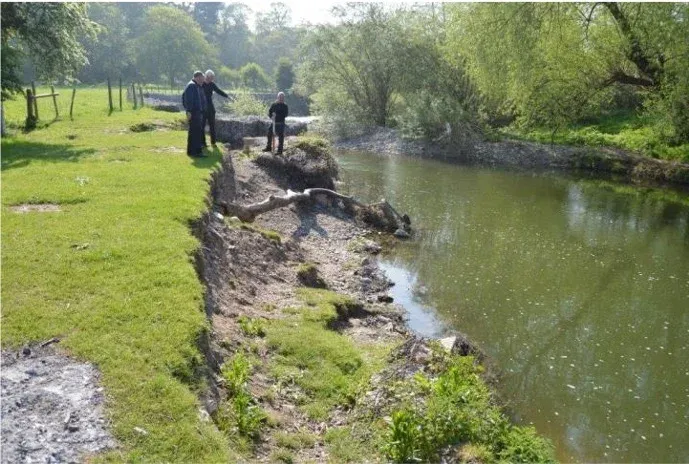Riverbank Collapse Iford Playing Fields incident in Bournemouth, UK, has raised major environmental and community concerns. Following a period of strong winds in late May, a significant portion of the riverbank near the popular recreational area gave way taking trees, soil, and debris into the river. The event not only shocked local residents but also highlighted the growing vulnerability of natural spaces to erosion and extreme weather patterns.
How the collapse happened, what caused it, its impact on the community, and the steps needed to ensure the safety and sustainability of Iford Playing Fields in the future.
Understanding the Riverbank Collapse Iford Playing Fields
Located in the Bournemouth suburb of Iford, Iford Playing Fields is a cherished open space used for walking, sports, cycling, and relaxation. Its close proximity to the river makes it a natural attraction for residents seeking outdoor leisure. However, that same proximity has now become a cause for concern.
In late May, residents noticed that a large section of the riverbank had collapsed into the water. Nicky Adams, a local dog walker, was among the first to report the damage, noting that it seemed to occur suddenly — almost overnight. What began as an ordinary week ended with a dramatic transformation of the landscape, leaving many questioning how such an event could happen so abruptly.
Timeline of the Riverbank Collapse Iford Playing Fields
The Riverbank Collapse Iford Playing Fields occurred around May 27, 2025, following several days of strong winds and unsettled weather. The section that gave way was significant, carrying trees and large chunks of soil into the river. The fallen debris partially obstructed the waterway, while the exposed bank left an unstable edge that has since caused concern for public safety.
Local residents quickly reported the incident to the Bournemouth, Christchurch, and Poole (BCP) Council, urging immediate action. The council acknowledged the situation, noting that erosion along this stretch of the river is not unusual — but the size of this particular collapse was far greater than normal.
Causes Behind the Riverbank Collapse Iford Playing Fields
Several natural and environmental factors are believed to have contributed to the Riverbank Collapse Iford Playing Fields:
- Strong Winds: The collapse followed a period of high winds that may have loosened soil and roots along the bank.
- Heavy Rainfall: Water saturation weakens the soil’s structure, making it more likely to slip or collapse.
- Vegetation Loss: Trees and plants help stabilize riverbanks with their roots. Once they fall or die, erosion accelerates.
- Natural Erosion: Over time, the river’s current naturally wears away the bank, gradually undercutting its foundation.
- Climate Impact: Increasingly erratic weather patterns are amplifying erosion risks in coastal and riverside areas across the UK.
Experts believe that a combination of these factors led to the sudden failure of the bank — a reminder that even well-used community spaces are not immune to nature’s power.
Community and Environmental Impact of the Riverbank Collapse Iford Playing Fields
The Riverbank Collapse Iford Playing Fields has multiple short- and long-term implications for the community and the environment.
Public Safety Risks
The immediate danger lies in the instability of the remaining riverbank. Walkers, children, and cyclists using the playing fields are at risk if they venture too close to the edge. Authorities have warned the public to stay cautious around the affected area until a full assessment is completed.
Environmental Consequences
The collapse displaced soil and trees into the river, altering its flow and potentially affecting aquatic habitats. Fallen vegetation can obstruct the current, slow drainage, and increase flood risks during heavy rainfall.
Loss of Green Space
Iford Playing Fields is a valued recreational area. Continued erosion could result in a long-term reduction of usable land and limit access to the riverside, impacting local quality of life.
Council and Community Response to Riverbank Collapse Iford Playing Fields
Following reports of the collapse, the BCP Council confirmed it was aware of the incident and has been working with partner organizations to monitor the situation. The council emphasized that erosion is a natural process in this part of Bournemouth but acknowledged the unusual scale of this event.
Many residents, however, have voiced frustration over what they perceive as slow communication and limited visible action. Social media discussions reveal concerns about potential risks to nearby infrastructure, including paths and the train bridge close to the playing fields.
Local environmental groups have suggested that the council prioritize stabilizing the area through ecological reinforcement, such as planting deep-rooted vegetation or installing natural retaining structures.
Preventing Future Riverbank Collapse Iford Playing Fields
Preventing another Riverbank Collapse Iford Playing Fields will require proactive, sustainable measures. Experts recommend a combination of natural restoration and engineering solutions:
- Reinforcing the Bank: Use of biodegradable mesh, retaining walls, or gabions to stabilize loose soil.
- Replanting Vegetation: Planting native grasses and trees with strong root systems to bind the soil.
- Drainage Improvements: Ensuring proper water flow to prevent excessive soil saturation.
- Monitoring and Maintenance: Regular inspections after storms or heavy rainfall to identify early signs of erosion.
- Public Awareness: Informing visitors about the dangers of unstable ground and temporary closures where needed.
Taking these steps could prevent further deterioration and preserve the natural beauty of Iford Playing Fields for future generations.
Lessons from the Riverbank Collapse Iford Playing Fields
This incident serves as a stark reminder of how natural processes, when intensified by changing weather patterns, can impact even familiar local landscapes. The Riverbank Collapse Iford Playing Fields highlights the importance of ongoing maintenance, environmental monitoring, and collaboration between councils, engineers, and communities.
Investing in prevention now will save future restoration costs and protect both people and nature. As Bournemouth continues to grow, balancing development with environmental preservation will be key to ensuring safety and sustainability across the region.
Conclusion
Riverbank Collapse Iford Playing Fields has brought attention to the delicate balance between nature and human activity. While erosion is a natural process, the severity of this collapse underscores the need for vigilance, planning, and community cooperation.
Moving forward, stabilizing the riverbank, restoring vegetation, and enhancing public awareness will be essential steps. With the right approach, Iford Playing Fields can recover and continue to be a safe, green, and thriving space for the Bournemouth community.





